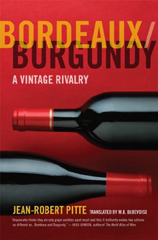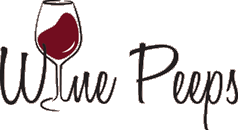Book Review: Bordeaux/Burgundy
By John ~ November 28th, 2008.
 When I first picked up Bordeaux/Burgundy: A Vintage Rivalry by Jean-Robert Pitte, I thought of another book that I read a few years ago, A Tale of Two Valleys: Wine, Wealth, and the Battle for the Good Life in Napa and Sonoma. The books are similar in concept, with A Tale of Two Valleys an American story and Bordeaux/Burgundy a French tale. Like Napa and Sonoma, Bordeaux and Burgundy have very different personalities but both make great wine.
When I first picked up Bordeaux/Burgundy: A Vintage Rivalry by Jean-Robert Pitte, I thought of another book that I read a few years ago, A Tale of Two Valleys: Wine, Wealth, and the Battle for the Good Life in Napa and Sonoma. The books are similar in concept, with A Tale of Two Valleys an American story and Bordeaux/Burgundy a French tale. Like Napa and Sonoma, Bordeaux and Burgundy have very different personalities but both make great wine.
Bordeaux is famous for its claret, the red blend carefully crafted from Cabernet Sauvignon, Merlot, and a smattering of one or more of three other approved varietals, Cabernet Franc, Petit Verdot, and Malbec (hardly ever used in Bordeaux today). Burgundy is famous for its single varietal wines crafted from either Pinot Noir (Red Burgundy) or Chardonnay (White Burgundy).
As Pitte writes in the Preface to the American Edition,
Not only do grape varieties differ between the two regions, but the practice of blending wines of the same vintage (or the refusal to do this) distinguishes their growers and merchants, who have in any case never sought to appeal to the same customers: Bordeaux has always made wines for export to the British Isles and northern Europe; Burgundy for a continental clientele of differing tastes and backgrounds.
I learned from this book that the owners of many of the top Bordeaux houses have traditionally been absentee owners who rely on employees to do the work in the vineyard and in the cellar, while Burgundy is mostly a huge collection of small owner-managed operations, true farmers in every sense of the word.
As Pitte says,
They are the product of different human temperaments, which have created and developed different wine-growing environments in different political, economic, and cultural contexts.
However, both Bordeaux and Burgundy do agree on one thing: terroir. And both are adamant that soil and climate exclusively determine the quality of their wines, a point with which I take issue. While I do agree that the terroir is important, I believe that good winemaking is important also.
Pitte spends a large portion of the book tracing an interesting history of winemaking in both regions. I found it especially noteworthy that traces of a vineyard dating from the first half of the first century have been uncovered in Bordeaux. He also discusses how it was the church that maintained the tradition of viticulture during the Middle Ages.
I also found it interesting that the physical environments in Bordeaux and Burgundy are very different. Bordeaux, which I have visited, is hot enough so that the grapes can ripen even on flat land; but not so in Burgundy, where exposures to the sun via the steepness of the slope in the vineyard are critically important.
While the international reputation of Bordeaux and Burgundy is fairly equal, far more Bordeaux is drunk throughout the world than Burgundy simply because it produces so much more wine. That’s also one of the reasons consumers have difficulty finding good Burgundy at an affordable price.
There is an old saying that summarizes the contrast between the two regions:
In Burgundy, everything is for drinking and nothing for sale, whereas in Bordeaux everything is for sale and nothing for drinking!
If you enjoy history and good wine, I believe that you will like this book so pick up a copy to read during the holidays.
Have you read Bordeaux/Burgundy? If so, what did you think of it?
Filed under: French Wine, Wine Books

 Wine Peeps is an independent wine blog dedicated to helping you get the most bang for your buck in wine. We do this through blind tastings of wine from around the world and calculations of
Wine Peeps is an independent wine blog dedicated to helping you get the most bang for your buck in wine. We do this through blind tastings of wine from around the world and calculations of 











Looks like a good book to uncork a bottle to and curl up by the fire this Winter and get reading.
I believe you are exactly right! Thanks for the comment
John